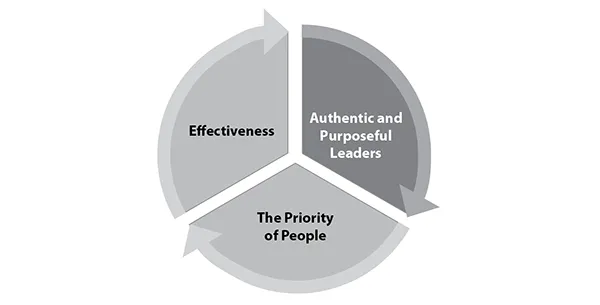Part 1
Beginning with Authentic and Purposeful Leaders
THROUGHOUT THE BOOK, we emphasize the priority of leaders focusing on followers. In order for leaders to effectively nurture their other-centered orientation, they must begin the journey by fostering authentic and purposeful character. In part 1 of the book, we begin with the importance of leaders modeling what matters (chap. 1). It is not enough for leaders simply to tell followers what is expected. Leaders must model these priorities through their authentic example.
In order to effectively model expected team behavior, leaders must also be willing to engage in honest self-evaluation (chap. 2). Authentic and purposeful leaders are willing to see both their strengths and their weaknesses, and to practice their leadership with humble self-efficacy and humble self-confidence. Leaders who truly want to serve and empower followers are those who take time to understand themselves.
Finally, authentic and purposeful leaders recognize that they do not have all the answers that their teams and organizations need. Because of this, teams and organizations today need leaders willing to foster a collaborative and team-oriented environment (chap. 3). By beginning with authentic leaders—leaders who model what matters, engage in honest self-evaluation, and foster collaboration—there is a basis for understanding the priority of people and navigating the team to effective mission accomplishment.
1
Modeling What Matters
Introduction
The life and leadership of Lt. Col. Hal Moore are depicted in the movie We Were Soldiers. In the painful realities of war, the importance of leadership practices like modeling what matters is intensified. While training his officers, he communicated that he came from the paratroopers, where the officer was always the first man out of the plane. He argued that this was so officers could follow their instincts and inspire their soldiers by example—being with them in the intensity of battle.
The film illustrates this priority with Moore’s speech to the Seventh Cavalry before going into the Battle of Ia Drang, where he makes this promise to his soldiers: “I can’t promise you that I will bring you all home alive. But this I swear before you and before Almighty God: that when we go into battle, I will be the first to set foot on the field, and I will be the last to step off. And I will leave no one behind. Dead or alive, we will all come home together. So help me God.” This commitment to being the first into battle and the last to leave exemplifies the core of our focus in this first chapter—modeling what matters.
If leadership is primarily about control through positional power, asking followers to do what they are told regardless of the leader’s example may work to a limited extent. However, if leadership is more about influence than control, the positive example and model of a leader is essential.
While it may be tempting simply to dictate to or tell followers what to do, the most effective leaders understand the importance of action. Leader behaviors provide a powerful example for followers. Leaders don’t just use words in their communication. Leaders communicate, for better or for worse, through their actions. Are these actions communicating the right message? Are they supporting the stated values and vision of the leader and organization?
On this point, Ken Blanchard and his associates call leaders to embody the values and vision of their organizations: “[It] is all about walking your talk. The leader, above all, has to be a walking example of the vision.” Inauthentic leaders can demand of followers what they as leaders are unwilling to do. Authentic and purposeful leaders, however, must model what matters and be willing to practice what they preach when it comes to expected organizational behavior.
Although the wartime situations that Hal Moore faced intensify the need for leaders modeling what matters, any organization with a clear vision needs this leadership practice. Effective and empowering leaders set an example for others. Through this example, leaders build mutual trust and affirm the common values shared by the community. Regardless of your leadership context, learning the importance of modeling what matters as a leader is essential. In this chapter, we explore the topic through the following perspectives: (1) modeling what matters in biblical perspective, (2) modeling what matters in contemporary perspective, and (3) modeling what matters in practice.
Modeling What Matters in Biblical Perspective
When something is important to someone, they tend to repeat it a lot. Consider these statements by the apostle Paul, scattered throughout his letters:
“Therefore I urge you to imitate me.” (1 Cor. 4:16)
“Follow my example, as I follow the example of Christ.” (1 Cor. 11:1)
“Join together in following my example, brothers and sisters, and just as you have us as a model, keep your eyes on those who live as we do.” (Phil. 3:17)
“Whatever you have learned or received or heard from me, or seen in me—put it into practice.” (Phil. 4:9)
“You became imitators of us and of the Lord.” (1 Thess. 1:6)
“For you yourselves know how you ought to follow our example.” (2 Thess. 3:7)
Paul’s leadership style is pretty obvious: “Follow my example”; “Imitate me”; “Put [what you have learned] into practice.” It is modeling. The best way to lead is not to tell people what to do but to show them by example. And showing involves more than just a training session. It is a complete lifestyle that exemplifies what matters most in life. For Paul, it meant modeling integrity, responsibility, investment, and equipping and empowerment.
Modeling Integrity
The New Testament letters known as 1 and 2 Thessalonians were written to a community of Christian believers in the city of Thessalonica in northern Greece. Paul had established this church shortly before, during his first major missionary outreach into Europe (about AD 50–52). Paul always started preaching his message of salvation in the Jewish synagogue, and most of his converts came from the Jewish community and their Gentile benefactors (known as “God-fearers”). The larger Jewish community in Thessalonica was not happy with this. They viewed this new community of Christ-followers in the way we would view a cult—a dangerous and subversive threat to their religious tradition. Paul’s life was threatened, and he was forced to flee Thessalonica (Acts 17:1–10). He continued his ministry, however, preaching in Berea, then in Athens and Corinth. Yet all along the way he was deeply concerned about this young church in Thessalonica. Would they abandon their newfound faith in the face of persecution? Were they strong enough to persevere?
Meanwhile, Paul’s opponents in Thessalonica sought to undermine his credibility. They accused him of many things: seeking personal ambition and praise, starting the church out of greed and desire to “fleece” the flock, and abandoning the young church at their moment of need. These were not outrageous claims, since the Greco-Roman world was full of unscrupulous traveling philosophers and preachers—the snake oil salesmen of the first century—who were always trying to make a buck off gullible customers. In a letter to the church, Paul responds to these accusations by pointing to his lifestyle while among them:
Paul says, “you know” how we lived among you, modeling integrity in every way. Far from taking advantage of them, Paul and his fellow missionaries were like parents to the Thessalonian believers, nurturing and caring for them. They shared with the Thessalonians not only their message but also their very lives. This is because they were accountable to a higher authority—God himself.
Integrity and authenticity are among the most important traits a transformational leader can model. Followers can sense hypocrisy a mile away. “Do as I say, not as I do” does not inspire transformed lives or motivated action. Confidence is inspired by congruence between our words and actions.
In addition to modeling integrity, a leader must model responsibility and competence, that is, the discipline and skills necessary to fulfill their responsibilities.
Modeling Responsibility
Throughout both 1 and 2 Thessalonians, Paul praises the believers at Thessalonica for their spiritual strength and maturity. Though young in their faith, this church was growing and thriving. Yet Paul also repeatedly tells certain members of the community to stop being idle or lazy and to get back to work (1 Thess. 4:11–12; 5:14; 2 Thess. 3:6–15). Scholars debate why these individuals were not working. Some think they expected Christ to return any day and so had quit their jobs and were living off the hospitality of others. Others think this has something to do with the Greco-Roman patronage system, where wealthy patrons would financially support clients in return for their loyalty, honor, and service. Since the church viewed itself as “family,” perhaps poorer members now viewed themselves as clients of the wealthier members and were taking advantage of their generosity. Whatever the reason for Paul’s concern, he takes these individuals to task for their irresponsibility and calls them to get back to work. He goes so far as to say that if someone refuses to work, they shouldn’t be allowed to eat! (2 Thess. 3:10).
Yet Paul doesn’t just give them orders, he points to his own example: “For you yourselves know how you ought to follow our example. We were not idle when we were with you, nor did we eat anyone’s food without paying for it. On the contrary, we worked night and day, laboring and toiling so that we would not be a burden to any of you. We did this, not because we do not have the right to such help, but in order to offer ourselves as a model for you to imitate” (2 Thess. 3:7–8). Paul says the same thing in his first letter to the church: “Surely you remember, brothers and sisters, our toil and hardship; we worked night and day in order not to be a burden to anyone while we preached the gospel of God to you” (1 Thess. 2:9).
As a full-time minister of the gospel, Paul could have lived off the support of others. But instead he set an example by taking responsibility for his own financial support. If we as leaders expect others to fulfill their responsibilities, we need to go above and beyond in our own duties and responsibilities.
Modeling Investment
In 1 Corinthians 11:1, Paul again emphasizes his modeling of leadership style: “Follow my example, as I follow the example of Christ.” Here the example he is referring to has been set out in the previous three chapters (1 Cor. 8–10). The issue under debate at Corinth was whether Christians should eat food that had been sacrificed to idols. Most food in a Greco-Roman marketplace had been offered to a pagan god, and some Christians were claiming followers of Christ should abstain from such tainted food. Paul essentially responds that there is nothing wrong with eating such food, since an idol is nothing but wood and stone (8:4–6; 10:25–26). At the same time, Paul stresses his willingness to give up this right so as not to cause a Christian brother or sister—for whom that idol seems very real—to fall into sin. The cause of the gospel is so great that it is worth sacrificing everything for. Paul writes, “Though I am free and belong to no one, I have made myself a slave to everyone, to win as many as possible. To the Jews I became like a Jew, to win the Jews. . . . To those not having the law I became like one not having the law. . . . I do all this for the sake of the gospel” (9:19–23).
For Paul, the good news of salvation is worth any amount of investment, whether time, money, or resources. Leaders inspire...

